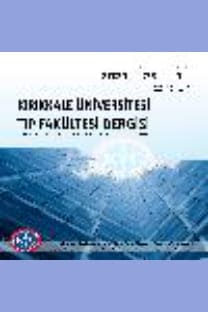Fetal Morbiditeyi Öngörmede Umblikal Arter Kan pH’i ve Birinci Dakika APGAR Skorunun Değerleri
Fetal distress, APGAR skoru, umblikal kord pH
Pages 9-14
Fetal distress, APGAR score, umbilical cord pH,
___
- Boehm FH, Fields L. Correlation of the one minute Apgar score and umbilical cord acid-base status. South Med J. 1979;(4): 429, 1986
- Arısan K. Kadın Hastalıkları ve Doğum. Perinatal Tıp. Baskı. İstanbul. Nobel Tıp,1156-61. 1991.
- Marrin M. Paes BA: Birth asphyxia: Does apgar score have diagnostic value. Obstet Gynecol. 1988; 72(l): l20-3.
- Page FO. Marlin JN. Palmer SF, Martin RW. Lucas JA, Meeks R, Bucovaz IT. Morrison JO Correlation of neonatal acid-base status with Apgar scores and fetal heart ratetracings. Am J Obstet Gynecol. 1986; 154(6): 1306-11.
- Dennis J, Johnston A. Mutch L, Yudkin P, Johnston P. Acid-base status at birth and neurodevelopment outcome at four and one-half years. Am J Obstet Gynecol. 1989; 161: 213-20
- Vintzilcos AM. Galfncy SIİ, Salinger LM. Kontopulos VG. Campbell WA. Nochimson DJ. The relationships among the fetal biophysical profile, umblical cord pH and Apgar scores. Am J Obstet Gynecol. 1987; 157(3): 627-31.
- Goldaber KG, Gilstrap LC. Correlations between clinical events and umbilical cord blood acid-base and blood gas values. Clin Obstet Gynecol. 1993; 36: 47-59
- Royal College of Obstetricians and Gyaecologists. Intrapartum Fetal Surveillance in Spencer J.A.D, Ward R.H.T (eds), London, RCOG Press, 1993, 392
- Thorp LA, Sampson LE. Routine umblical cord blood gas determi nations. Am J Obstet Gynecol. 1989; 600.
- Nelson KB, Ellenberg JH. Apgar scores as predictors of chronic neurologic disability. Pediatrics. 1981; 68: 36.
- Karin B, Nelson MD. Perinatal asphyxia. Clinics in Perinatology. 1993; 2: 327.
- Sarnat HB, Sarnat MS. Neonatal encephalopathy following fetal distress. Arch Neurol. 1976; 33: 695 Jack N, Blechner MD: Maternal-fetal acid-base physiology. Clin Obstet Gynecol. 1993; 36: 30.
- Nelson KB, Leviton A. How much of neonatal encephalopathy is due to birth asphyxia? AmJ Dis Child. 1991; 145: 1325.
- Van Den Berg P, Schmidt S, Gesche J, Saling E. Fetal distress and the condition. Obstet Gynaecol. 1987; 94: 72-6, Nelson KB, Ellenberg JH. Apgar scores as predictors of chronic neurologic disability. Pediatrics. 1981; 68: 36
- Nelson KB, Leviton A. How much of neonatal encephalopathy is due to birth asphyxia? AmJ Dis Child. 1991; 145: 1325
- Kubli FW, Hon EH. Observations on hart rate and pH in the human fetus during labor . Am J Obstet Gynecol. 1969; 104: 1190
- Suiden JS, Young BK. Acidosis in the vigorous newborn. Obstet Gynaecol. 1985; 65: 361
- Josten EB, Johnson RB, Nelson PJ. Umbilical cord blood pH and Apgar scores as an index of neonatal health. Am J Obstet Gynecol. 1987; 157: 843
- Boehm FH, Fields L. Correlation of the one minute Apgar score and umbilical cord acid-base status. South Med J. 1986; 79: 429
- Cetrulo CL, Schifrin BS. Fetal heart rate patterns preceding death in utero. Obstet Gynecol. 1976; 48: 5
- Goldenberg RL, Huddlestone JF, Nelson KG. Apgar score and umbilical arterial Ph in preterm newborns. Am J Obstet Gynecol. 1984; 149: 651
- Van Den Berg P, Schmidt S, Gesche J, Saling E. Fetal distress and the condition of the Obstet. Gynaecol. 1987; 94: 72-6
- Sykes GS, Mallory PM, Johnson P: Do Apgar scores indicate asphyxia? Lancet. 1982; 1: 494
- Hobbart J. Postterm pregnancy. Clinics in Perinatology. 1989; 16(4): 909-15
- American Academy of Pediatrics, Commitee on fetus and newborn: Use and abuse of the Apgar score. Pediatrics 78: 1148, 1986
- Gilstrap LC. Fetal acid-base balance. In R.K Creasy andR. Resnik, (eds.), Maternal -Fetal Medicine,ed4. Philadelphia, WB Saunders, 1998; 331
- Gordon A, Johnson JWC. Value of umblical blood acidbase studies in fetal assessment. J Reprod Med. 1985; 30: 329-36
- Gilstrap LC. Fetal acid-base balance. In R.K Creasy andR. Resnik, (eds.), Maternal -Fetal Medicine,ed4. Philadelphia, WB Saunders, 1998; 331
- Thorp JA, Rushing RS. Umbilical cord blood analysis.Clin Obstet Gynecol 1999; 26(4): 695-709
- Paneth N, Folks H. The relationship of Apgar score to neurologic handicap: A survey of clinicians. Obstet Gynaecol. 1983; 61: 547
- Fields IM, Entman SS, Boehm FH. Correlation of one minute Apgar score and the pH value of umbilical arterial blood. South Med J. 1983; 76: 1477
- Perlman JM. Systematic abnormalities in term infants following perinatal asphyxia. Clinics Am Perinatology. 1989; 16: 475 Yazışma Adresi: Osman Köse
- Yenimahalle Devlet Hastanesi Kadın Hastalıkları ve Doğum Bölümü Yenimahalle /Ankara Tel: (0312) 587 2214
- E-posta: dr.osmankose2004@mynet.com
- ISSN: 2148-9645
- Yayın Aralığı: Yılda 3 Sayı
- Başlangıç: 1999
- Yayıncı: KIRIKKALE ÜNİVERSİTESİ KÜTÜPHANE VE DOKÜMANTASYON BAŞKANLIĞI
Fetal Morbiditeyi Öngörmede Umblikal Arter Kan pH’i ve Birinci Dakika APGAR Skorunun Değerleri
Plasenta Previa ve Uzamış Membran Rüptürü Olan Olguda İhmal Edilmiş Mentum Posterior Yüz Geliş
, Rukiye Ada BENDER, Aykan YÜCEL, Volkan NOYAN, Gülsüm Yıldız SERBEST, Nevin SAĞSÖZ, Çağatay BÖLGEN
İnguinal Herni-Prostatizm Birlikteliklerine Güncel Yaklaşım
Aybala Ağaç Ay, , Volkan Kınaş, Işın Gençay, Abdullah Çetin
Akut Apandisitte Preoperatif Tetkikler-Laparotomi Korelasyonu
Aybala AĞAÇ AY, , Volkan KINAŞ, İşın GENÇAY, Abdullah ÇETİN
Uzun Mezorşiuma Bağlı Testis Torsiyonu: Olgu Sunumu
, Süleyman AYVAZ, Salih KARACA, Hakan GENÇHELLAÇ, Mehmet KİRİCİ, Ekrem ÇANCİLAR, Mehmet PUL
, Murat Tulmaç, Hatice Özdemir, Ömer Şahin, Fatih POYRAZ, Vedat ŞİMŞEK, Derya CANLI, Haksun EBİNÇ
Tonsillektomi Sonrası Geç Kanama - Olgu Sunumu
Bengi ARSLAN MUTLU, , Hatice GÜZELKÜÇÜK, Rahmi KILIÇ
İnhalasyon Yaralanmalarının Tanı ve Tedavisi: Literatürün Gözden Geçirilmesi
